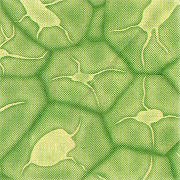Plant Anatomy Archive
Sclereids typically are short cells with thick secondary walls, strongly lignified, and provided with numerous simple pits. Some sclereids have relatively thin secondary walls, however, and may be difficult to distinguish from sclerified parenchyma cells. The thick-walled forms, on the other hand, may strongly …
Fibers typically are long, spindle-shaped cells, with more or less thick secondary walls, and they usually occur in strands. Such strands constitute the “fibers” of commerce. The process of retting (technical form of the word rotting) used in the extraction of fibers from the plant …
The term sclerenchyma refers to a tissue composed of cells with secondary walls, often lignifi ed, whose principal function is mechanical or support. These cells are supposed to enable plant organs to withstand various strains, such as may result from stretching, bending, weight, and pressure …
The term parenchyma refers to a tissue composed of living cells variable in their morphology and physiology, but generally having thin walls and a polyhedral shape, and concerned with vegetative activities of the plant. The individual cells of such a tissue are parenchyma cells. …
MACROMOLECULAR COMPONENTS OF THE CELL WALL Cellulose Is the Principal Component of Plant Cell Walls The principal component of plant cell walls is cellulose, a polysaccharide with the empirical formula (C6H10O5)n. Its molecules are linear chains of (1→4)β-linked-D-glucan (repeating monomers of glucose attached end …
The presence of a cell wall, above all other characteristics, distinguishes plant cells from animal cells. Its presence is the basis of many of the characteristics of plants as organisms. The cell wall is rigid and therefore limits the size of …
